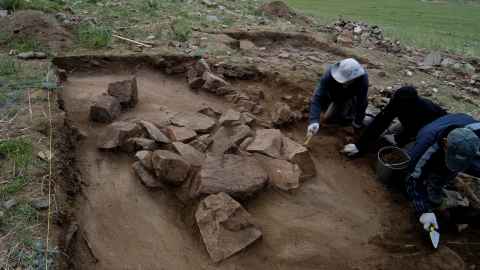Life and death during the Mongolian Bronze Age
20 March 2019
New research has shown that Bronze-Age Mongolians probably lived in small nomadic groups that had a relatively well-balanced diet and used horses for transportation.

The research was undertaken on the remains of 25 individuals excavated from burial mounds in the Hovsgol province of northern Mongolia by a collaborative team from the Mongolian Academy of Sciences, the Smithsonian Institute and the University of Auckland — which included Master of Arts student Sarah Karstens and her supervisor Professor Judith Littleton.
The team's analysis showed that these individuals — who lived between about 3,500 and 2,700 years ago — showed very little evidence of inflammation or infection in the bones, or signs of diseases brought on by malnutrition such as rickets or scurvy. This indicates a group of people who experienced few health insults and little stress.
What they did find were injuries indicative of violence and close contact with animals, such as broken noses, ribs and legs. Wear and tear in spines and shoulders which could be associated with horse-riding was also noted. This lends further evidence to the suggestion that the reality of the popular image of the nomadic pastoralist roaming the Mongolian steppe on horseback may have had its genesis during the Bronze Age.
The most significant findings relate to the potential evidence of horse riding and the lack of evidence for nutritional deficiencies.
Sarah wrote about these findings in her MA thesis, which was the basis for an article published in the November 2018 issue of HOMO.
She says that "the most significant findings relate to the potential evidence of horse riding and the lack of evidence for nutritional deficiencies".
"The timing of the introduction of mounted pastoralism has been something that researchers have been trying to pin down due to the wide-ranging implications for shifts in culture, trade, warfare and socio-political organisation.
"While this small sample alone does not provide concrete evidence for horse riding, the patterns of degenerative changes and trauma are consistent with what might be expected based on studies of modern riders. This adds to the growing body of evidence that it was during the Bronze Age that this transition to mounted pastoralism took place.
"It has also been suggested that the relatively narrow diet — predominantly meat and dairy — may have led to some forms of nutritional deficiency. We found little to no evidence of nutritional deficiencies in our site which, coupled with the lack of evidence for infectious disease, suggests changes in population density and diet between the Bronze Age and the slightly later periods such as the Xiongnu and Han."
Sarah says that "in the future it would be great to go back out into the field and excavate more burial mounds in order to be able to expand our sample size".
Media queries
Julianne Evans | Media adviser
DDI: 09 923 6589
Mob: 027 562 5868
Email: julianne.evans@auckland.ac.nz